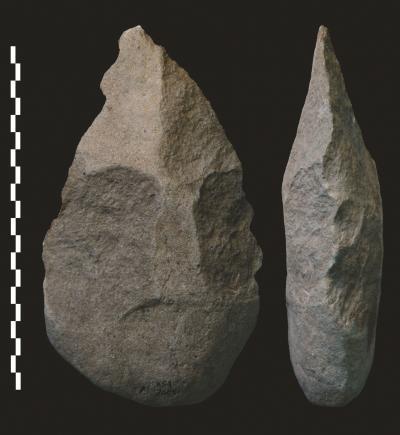We're open daily! View holiday hours
Science News
Advanced Stone Tools
September 1, 2011

These days technology advances pretty quickly—turnaround for a minute and your iPhone has fallen 2Gs behind.
Not so for our early ancestors. Tool types were around for tens of thousands—if not hundreds of thousands of years—before progressing to the next stage. Early stone tools known as Oldowan were simple, “dating back to about 2.6 million years ago and persisting to about 1.7 million years ago,” according to ScienceNOW. More complicated stone tools, known as Acheulian, appeared later and “persisted until about 100,000 years ago.”
Now, a new study suggests that Homo erectus, a precursor to modern humans, was using advanced Acheulian tools in East Africa 1.76 million years ago, at least 300,000 years earlier than previously thought. The study, recently published in Nature, raises new questions about how these tall and slender early humans developed sophisticated tool-making technology.
In the summer of 2007, a team of French and American researchers traveled to Kenya's Lake Turkana in Africa's Great Rift Valley, where Earth’s plates are tearing apart—and where some of the earliest humans first appear. Anthropologist Richard Leakey's famous find—Turkana Boy, a Homo erectus teenager who lived about 1.5 million years ago—was excavated on Lake Turkana's western shore in 1984 and remains the most complete early human skeleton found so far.
Six miles from Turkana Boy, the researchers headed for Kokiselei, an archeological site where both Acheulian and the simpler Oldowan tools had been found earlier. Their goal: to establish the age of the tools by dating the surrounding sediments. At Lamont-Doherty’s Paleomagnetics Lab, they compared the magnetic intervals with other stratigraphic records, dating the archeological site to 1.76 million years ago.
“We suspected that Kokiselei was a rather old site, but I was taken aback when I realized that the geological data indicated it was the oldest Acheulian site in the world,” said the study's lead author, Christopher Lepre, a geologist from Lamont-Doherty. The oldest Acheulian tools previously identified appear in Konso, Ethiopia, about 1.4 million years ago, and India, between 1.5 million and 1 million years ago.
Researchers found it surprising that the tools dated to the same epoch, but it also seems that when Homo erectus migrated to Asia, they abandoned the more advanced technology.
“The Acheulian tools represent a great technological leap,” said study co-author Dennis Kent, a geologist also from Lamont-Doherty. “Why didn't Homo erectus take these tools with them to Asia?”
Eric Delson, a paleoanthropologist at Lehman College who was not involved in the study, wonders if Homo erectus “lost” the Acheulian technology on the way. ScienceNOW puts it in a seemingly frustrating way from today’s modern technology perspective:
Even though the Acheulian tools had been invented, those who made them may have perished without passing on their skills, meaning that another group may have had to reinvent the same tools thousands of years later.
It makes your iPhone 3G seem not so dated after all…
Image: Pierre-Jean Texier, National Center of Scientific Research, France